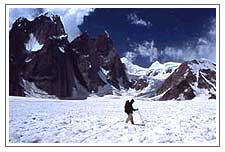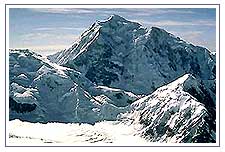
What
can make a mountaineering expedition, an adventure one could never forget?
If its done on the glaciers that are still craving to be explored. The
Himalayan range offers some of the most rigorous mountaineering challenges
one can ever come across. The glaciers of Ladakh and Kashmir regions can
test one's survival to the fittest and most testing of them all is the
Siachen glacier, known as the largest glacier outside the Polar Regions.
The Siachen glacier lies in the extreme north-central part of Jammu and
Kashmir near the border of India and Tibet. With a length of about 72-km,
Siachen is known as the largest glacier in the world outside the Polar
Regions. Located on the north-facing slopes of the Karakoram Range, Siachen
feeds the Mutzgah or Shaksgam River that flows parallel to the Karakoram
Range before entering into Tibet.
Large tributary glaciers like the Shelkar Chorten and Mamostang open into
the main glacier from both sides of its trough. The trunk glacier and its
tributaries are in the form of a vast ice field, particularly during the
winter season when there is continuous snowfall for several weeks at a
stretch.
A Mountain Of Ice

The
Siachen glacier lies in a vast trough more than 2-km wide and the sides of
the glacier are strewn with rocks and boulders. The central part of this
glacier, however, is a vast snowfield.
Numerous icefalls have been formed at the junction of small valley glaciers
and the trunk glacier. Lateral moraines occur at the confluence of larger
tributary glaciers and the trunk glacier. The sidewalls of the glacial
trough are steeply sloping and avalanches roll down these slopes quite
often, particularly in winter.
This glacier encompasses a vast are in winter. There are virtually no signs
of recession. This tract is more or less devoid of a vegetative cover due to
its high elevation as well as its latitude. The bulk of the total annual
precipitation is in the form of snow.
A Group Of
Glaciers
To the east of the Siachen lies the Rimo glacier group, a group of three
glaciers -- North, Central and South -- located at an altitude of between
6,000 and 7,000 m above sea level. Between them, these glaciers have almost
700 -sq-kms of ice, which at places is 100 m deep. Thus the Siachen glacier
empire contains about 2,000-sq-kms of ice surface and almost 200 cubic
kilometers of ice.
Accissible
The Siachen glacier can be approached via Skardu in Ladakh.

Situated
on the southern slopes of the Karakoram Range in the Baltistan area of
Ladakh is Hispar Glacier. A very large glacier feeding the main stream of
the Shigar River, which in turn drains into the Indus River. The main
glacier has a length of about 60-km and is the third largest glacier in the
Himalayan region.
Numerous smaller glaciers join the main glacier on both sides of the
amphitheater in which it is located. The central portion of this glacier is
a vast snowfield while its sides contain debris eroded by the huge body of
moving ice. The entire tract is completely lacking in vegetation of any
kind.
Accissible
The Hispar glacier can be approached via Skardu in Ladakh.
 What
can make a mountaineering expedition, an adventure one could never forget?
If its done on the glaciers that are still craving to be explored. The
Himalayan range offers some of the most rigorous mountaineering challenges
one can ever come across. The glaciers of Ladakh and Kashmir regions can
test one's survival to the fittest and most testing of them all is the
Siachen glacier, known as the largest glacier outside the Polar Regions.
What
can make a mountaineering expedition, an adventure one could never forget?
If its done on the glaciers that are still craving to be explored. The
Himalayan range offers some of the most rigorous mountaineering challenges
one can ever come across. The glaciers of Ladakh and Kashmir regions can
test one's survival to the fittest and most testing of them all is the
Siachen glacier, known as the largest glacier outside the Polar Regions.





 The
Siachen glacier lies in a vast trough more than 2-km wide and the sides of
the glacier are strewn with rocks and boulders. The central part of this
glacier, however, is a vast snowfield.
The
Siachen glacier lies in a vast trough more than 2-km wide and the sides of
the glacier are strewn with rocks and boulders. The central part of this
glacier, however, is a vast snowfield.  Situated
on the southern slopes of the Karakoram Range in the Baltistan area of
Ladakh is Hispar Glacier. A very large glacier feeding the main stream of
the Shigar River, which in turn drains into the Indus River. The main
glacier has a length of about 60-km and is the third largest glacier in the
Himalayan region.
Situated
on the southern slopes of the Karakoram Range in the Baltistan area of
Ladakh is Hispar Glacier. A very large glacier feeding the main stream of
the Shigar River, which in turn drains into the Indus River. The main
glacier has a length of about 60-km and is the third largest glacier in the
Himalayan region.